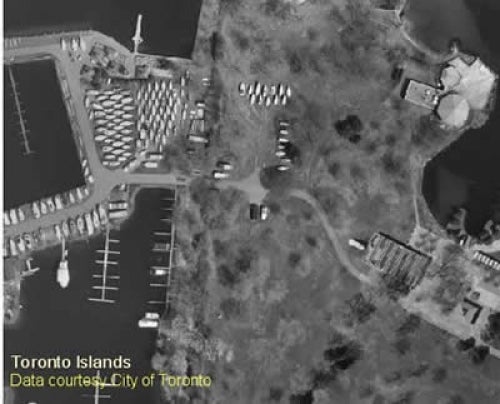Contact the Geospatial Centre
Dana Porter Library, Room 328
University of Waterloo Library
Waterloo, Ontario N2L 3G1
Email: librarygeo@uwaterloo.ca
This data resource consists of 3,084 individual black and white orthoimages which provide coverage of the City of Toronto. These images were flown in 2003 by J D Barnes and then provided to the Geospatial Centre by the City of Toronto, Geospatial Competency Centre in June 2005. The resolution of these photos is 7.5 cm.
A detailed 2003 index provides the 9-digit tile identifier (e.g. 6320 48580) for each image. Please use this index to determine the tile identifiers of the images that interest you.
These georeferenced images are available in Universal Transverse Mercator (UTM) zone 17, North American Datum (NAD)83 coordinate system. They are stored as compressed MrSID data files, with accompanying Sid World (SDW) data files. Average file size of one MrSID image is 4 MB.
To request this data, please fill out the Ask-Us form and include which layers (shapefiles) you are interested in obtaining. The dataset will be shared with you via OneDrive upon completion of the data release agreement form. You may also make an in-person appointment using the same form.
These data are provided for personal use for academic, research, and/or teaching purposes. A data release agreement must be agreed to before these licensed data can be released. The City of Toronto, Geospatial Competency Centre must be acknowledged on any derivative product, whether printed or electronic, including for example, a printed map, a raster or vector graphic, a web-based application, etc. Patrons are advised to fully respect the provisions of Canada's Copyright Act as well as terms and conditions imposed by the data provider.
City of Toronto 2003 orthoimagery [computer file]. Toronto, Ontario: City of Toronto Geospatial Competency Centre. [2003].

Data courtesy of the Geospatial Competency Centre, City of Toronto
Dana Porter Library, Room 328
University of Waterloo Library
Waterloo, Ontario N2L 3G1
Email: librarygeo@uwaterloo.ca
The University of Waterloo acknowledges that much of our work takes place on the traditional territory of the Neutral, Anishinaabeg, and Haudenosaunee peoples. Our main campus is situated on the Haldimand Tract, the land granted to the Six Nations that includes six miles on each side of the Grand River. Our active work toward reconciliation takes place across our campuses through research, learning, teaching, and community building, and is co-ordinated within the Office of Indigenous Relations.
Select 'Accept all' to agree and continue. You consent to our cookies if you continue to use this website.